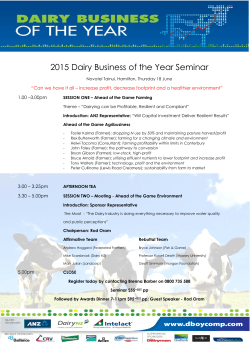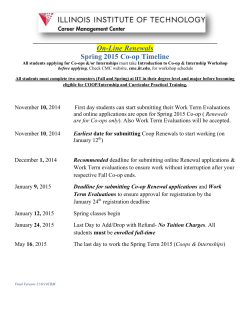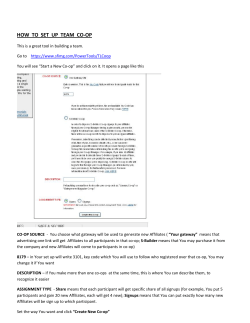
Manager`s Report - Farmers Coop Elevator
April 2015 www.farmcoop.com Manager’s Report BY DALE ANDERSON • General Manager • 308-487-3317 • dale.anderson@farmcoop.com Our fiscal year ended in February, and I am happy to report that your cooperative had another financially successful year. We measure success not only in terms of the net savings—which are indeed important—but also in terms of what we accomplished in building the company through facility and equipment upgrades and staff development. Our mission is to provide our members with quality products and services. It is what we keep in the front of our minds as we set about the daily tasks of delivering high-quality products and services. At the beginning of this year, we identified three areas of the business that I feel represent challenges for us going forward as we continue building the company and improving our level of service to you. The first is to achieve growth through better customer service. That simply means focusing on how we can take care of customers by giving our best efforts and putting the right people in place to service the business. It is a constant challenge to hire and retain the right people. It is one of the most, if not the most, important jobs of the management group. The second is to achieve growth by bringing innovation and expertise to the marketplace. Innovation is not just technology, but also looking for new and creative ways of doing business. At the same time, we are systematically developing expertise in all of our business units to meet the changing demands of producers and production agriculture. We are currently working to bring a new agronomy business system online that will integrate many of our crop planning and analysis functions with an order processing system. This system will also tie into the automated mixing and batching systems we have been putting into place over the last few years. The result should be better service to our customers, more efficient order management, and better internal controls. Mike Weisz discusses this system in more detail on page 3. The last area is to achieve growth by improving our teamwork. We operate several business units that, while each have different operational environments, have many overlapping skills and complementary seasonal needs. Working together will help create a whole company that is greater than the sum of all of the individual parts. These three things are what we will focus on this year. In addition, as you will learn later in the newsletter, we continue to make the investments in the facilities and equipment that we need to meet the demands of our customers. It will be a very busy year indeed. Have a safe and productive spring. ● Cooperation Benefits Two Communities BY BART MOSEMAN • Grain Division Manager • 308-487-3325 • bart.moseman@farmcoop.com The start of the new Farmer’s Co-op fiscal year on March 1 signaled the start of a new project. You will soon see three shiny new steel tanks rising on the north side of Hemingford. Farmer’s Co-op is putting up a dry edible bean storage facility for use by New Alliance Bean and Grain. As Farmer’s Co-op completes this project, New Alliance Bean and Grain will complete an expansion of their facility in Alliance that Farmer’s Co-op patrons will be able to use for wheat and corn. The dry edible bean facility in Hemingford will have a 190,000-bushel capacity and will replace an old flat storage building that was used to store pinto beans. Dumping capacity is rated at 7,500 bushels per hour, which is a vast improvement over the dumping capacity of the old flat building. New Alliance’s expansion project in Alliance is adding 440,000 bushels of storage capacity, along with a new 20,000-bushelper-hour leg. These improvements in Alliance will provide Farmer’s Co-op with better merchandising capabilities, thanks to the added storage, and better customer service for our patrons due to increased dumping capacity. We are excited to be able to receive corn at the New Alliance facility this coming fall. In addition to our facility expansion, we’re also adding a new semi-tractor to expand our grain department truck fleet. Market update The grain markets were non-exciting all winter. The market continues to deal with adequate supplies of both corn and wheat; a situation that isn’t lending itself to many good marketing opportunities. Since Christmas, the trend has been lower, especially for wheat. A higher U.S. dollar and no real supply worries in the rest of the world have made U.S. wheat uncompetitive, and exports have suffered. Snow has fallen in many of the HRW areas, and once in a while, we hear talk of winterkill, but the market isn’t buying any of that news yet. Rail shipments of Farmer’s Coop wheat have gone primarily to the Texas Gulf for export so far this year. It’s somewhat of the same story with corn. Good yields this past fall led to a large supply that the market has to eat through. There is still quite a bit of corn in our area, as evidenced by the corn piles visible in many communities. Thanks to our shipping capabilities, we’ve been able to add value to much of the corn we’ve received by finding markets outside our immediate trade area. We picked up 1.1 million bushels of corn from ground piles by March 1 and have shipped two corn shuttles totaling approximately 880,000 bushels to the Texas panhandle and Mexico. Finally, I’d like to welcome Tucker Hamilton to the Farmer’s Coop grain team as our new grain originator. You can read more about Tucker below. ● Brand New Nebraskan Go Huskers! My name is Tucker Hamilton and I am originally from Newcastle, WY. I am a recent University of Wyoming graduate with bachelor’s degrees in animal science and agricultural business, and am currently finishing up a master’s degree in agricultural economics. I am happy to be a new resident of the state of Nebraska and a member of the Farmer’s Co-op team. I am eager to bring my education to work for our customers, and I am looking forward to the new experience. I would like to introduce the Farmer Scoop blog I post, in which I do a weekly market analysis, summarize market news, and provide marketing tips to farmers in the area. You can check it out at farmerscoop.wordpress.com. If all goes well, I will soon have guest bloggers from agronomy and feed providing expanded content on topics such as production costs, buying inputs, and overall risk management. I am quickly getting to know the area and our customers, and I look forward to working with you. If I have not been out to see you yet, I soon will be. I want to visit with you about opportunities to market grain in this new price environment we have not seen in a few years. If you want to talk to me or schedule a farm visit, you can contact me at my office (307-487-3325), text or call me on my cell (308-360-0830), or email me at tucker.hamilton@farmcoop. com. ● Bringing Value to Your Bottom Line BY MIKE WEISZ • Agronomy Division Manager • 308-487-3317 • mike.weisz@farmcoop.com We all face the same challenge these days of lower prices and tighter margins—spending every dollar in a way that delivers the greatest value. The trick comes in distinguishing value from price. The fact is, price is only one component of value and may not even make the biggest impact on your bottom line in the long run. For example, you can buy herbicides just about anywhere, including online. When you buy that product, however, that may be all you receive. On the other hand, when you purchase herbicide—or any production input—from Farmer’s Co-op, you also receive a team committed to customer service and equipped to back that product purchase. Back to the herbicide example. Do you ever need a highly trained applicator to apply that product when you don’t have the time or equipment necessary to cover all your acres? We invest in hours of training each year so our applicators can get the job done right the first time. Do you have all the eyes you need on your field to spot weed and pest problems or diagnose nutritional deficiencies? Our skilled agronomists are available to do that when needed. The investment we’ve made in hiring and training our people, in addition to purchasing and maintaining our application fleet, is reflected in the price of the products we sell. You will probably always be able to find a lower price, but if you’re looking for knowledgeable agronomic advice and product support, highly trained applicators, and responsive service, you won’t find a better value than Farmer’s Co-op. What’s new in agronomy? liquid fertilizer blending system. The system incorporates a mass-flow meter, which will provide a legally accurate weight while measuring product. The system will be linked to a Kahler Plant Manager software package, which will control the liquid fertilizer valves and disbursement of the blended product. Two advantages of this system are that it will blend the product more accurately than our previous system and that we won’t have to run each load over the truck scale to get a weight. We did some equipment shuffling within the two main locations. The Case IH® 3340 sprayer that was in Hemingford was moved to the Gordon location, so Gordon will now have two 2014 Case IH 3340 models there plus the AGCO 1300. A new AGCO 1300 sprayer has been ordered for the Hemingford location to join the existing AGCO 1300 that we have had for two seasons. We also are adding almost $70,000 worth of liquid nurse tanks and trailers to help meet increasing demand. We have been looking at the AgWorks AgOS® software package for several years and finally felt it was the right time to move forward with it. The Crop Planning component will allow our growers to make well-informed agronomic decisions while working closely with our sales agronomists. Ultimately, you will receive a comprehensive plan that will make it easy to understand input costs and agronomic variables that will affect future decisions and profitability. Internally, it will also give us much-needed support to better utilize our applicators and equipment so we can minimize application delays. In addition, it will interface with the automated liquid fertilizer plants in both Gordon and Hemingford and the dry plant in Hemingford, allowing us to send batch orders to those systems for blending and dispensing. It will bring speed and efficiency to our operations and support our goal of increased productivity through the use of technology. ● New for Gordon agronomy will be the new computerized Utility Player Versatility is a strength for New Farmer’s Co-op employee Tracy Neidig, who works for the grain, agronomy, and feed departments and heads up customer service in Hemingford. Tracy grew up on a row crop farm and cow/calf operation in northeast Nebraska. Growing up, she was active in 4-H and served on the youth 4-H Council. Later she served on the County Extension Board and 4-H Council and volunteered with the 4-H program. She actively maintains her purebred Simmental herd, building the genetic potential of her homeraised replacements. She graduated from South Dakota State University with a bachelor of science in animal science and a minor in agricultural business, Prior to transferring to SDSU, Tracy attended Northeast Community College, where she competed on the livestock judging team. She enjoys photography, traveling, and actively participating in local and state agricultural organizations. ● ©2015 Farmer’s Co-op. All Rights Reserved. Published in partnership with VistaComm® (www.VistaComm.com). P.O. Box 155 317 Osborn Hemingford, NE 69348 Hemingford 308.487.3317 Gordon 308.282.0638 Hay Springs 308.638.4462 Gordon Mill Reborn BY TIM TANKERSLEY • Feed Division Manager • 308-360-1406 • tim.tankersley@farmcoop.com We just installed the final piece of our reborn feed mill, our new roller mill. Now we can generate the same level of nutrition in a grain mix as you would find in cubes or pellets at a fraction of the cost. Bring your ration needs to us and see what we can do for you and your bottom line. The board of directors has also approved the purchase of a new feed delivery truck. We’re planning on a 16-18-ton straight truck, so I’m currently shopping with manufacturers to put together what we need. Take care of momma In this hot beef market, a bred cow is worth 2-3 times the value of an open animal. So, it is well worth the investment to take very good care of your cows (and bulls). Good mineral nutrition is essential through the post-calving recovery and breeding season, and we have a full line of both weatherized and meal-type minerals. We also have all the IGR, CTC, and high-mag minerals for fighting flies and improving health when cattle are out on the grass in the summer. Plan to maximize profits this summer by creep feeding your calves with our Ranger controlled consumption creep feed program. We have a solid history of success using this innovative technology. The current feed ingredient markets are starting to soften. We are waiting to lock in prices for our creep programs until the prices settle into a favorable range. We should have creep feed booking prices available by May. I’m pleased to welcome three new employees to the feed department. Justin Anderson is our new feed salesman. He is a Gordon native who earned an ag business degree from Northwest Community College and worked in grain origination for 11 years prior to joining us. He also has a farm and ranch operation to keep him busy nights and weekends. Justin and his wife, Kelli, have four children. Dan Sasse, another product of the Sandhills, earned his degree in exercise science from Chadron State. He works in our warehouse and is being trained to operate our new feedmill. He and his wife, Tory, are newlyweds. Finally, Kylee Pettera is a McCook, NE, native with associate degrees from McCook Community College and Nebraska College of Technical Agriculture. She is working in the Gordon store handling all animal health and merchandise sales. Kylee has a son, JD. ● Justin Anderson Dan Sasse Kylee Pettera
© Copyright 2025










